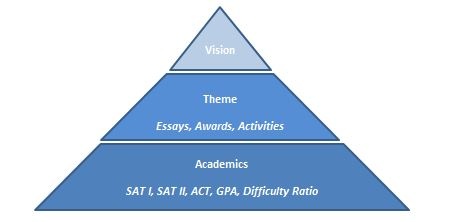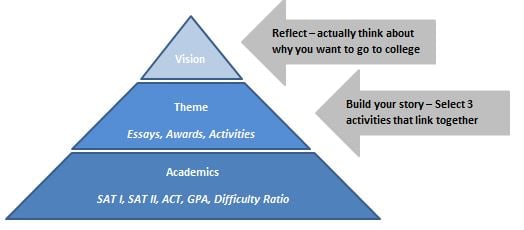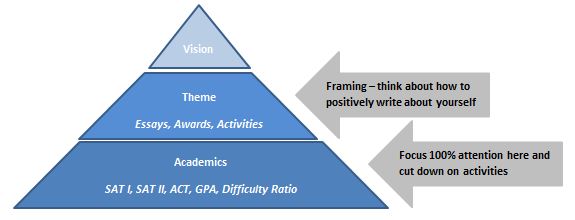One of the most common questions we get asked every year by high school students revolves around course selection. Some students ask how many Advanced Placement (AP) courses they should take. Others wonder if they should pursue college courses outside of school. When it’s available, some consider if they should pursue an International Baccalaureate (IB) program. It is true that taking a more difficult course load can improve your chances of admissions. However, that must come with good grades, an overall record of course difficulty, and a convincing extracurricular activities story. In this article, we’ll dig into how GPA will affect your college admissions journey.
In this article, we hope to convey how admissions officers view the academic component of an applicant. We will take three cases: the high achiever, the splitter, and the reach case. Most students fall into one of the first two buckets, or have a reasonable explanation for being in the third.
The Pyramid
Academics accounts for the base of a pyramid that is the applicant. Without it, applying to target and reach schools is difficult. With it, we need to build a convincing story on top of it to showcase our ability to learn and grow outside of a testing environment.

The High Achiever
The high achiever has taken 8-15 Advanced Placement (AP) courses or is working towards an IB degree. They have above a 3.9 unweighted GPA and an SAT above 2250. The high achiever checks off the “academics” part of the pyramid, but is always looking for another edge. The high achiever should focus on developing a concise and specific theme with activities outside of school and actually reflecting on the work they have put into their high school career. This will help them gain the edge they need. Additionally, this reflection will demonstrate maturity in your writing, which will boost your chances of admission.
Here is why:
Most admissions officers will look at an applicant’s numbers early in the review process. The high achiever will get a mention of their academic strength, but readers quickly move on to the rest of the application. Schools like Stanford and Harvard have repeatedly said that they can fill classes with perfect scorers, but have the liberty to choose a diverse class. The way to gain an edge is to apply to many programs and have a specific, memorable story. Therefore, focus on the top two areas of the Empowerly Pyramid. As you can see, even for high scorers, GPA does affect college admissions by providing focus for the rest of the application.

The Splitter
The splitter has a stronger SAT than GPA, relatively, or vice versa. Often they are in the top 25% of their class in terms of grades, and know this fact. These students can do three things to improve their chances of admissions: be selective about course selection, plan out a testing strategy, and build up activities in a cautious fashion.
1. Course Selection
For splitters, the balance between AP courses and maintaining GPA is critical. In general, one extra AP course does not help as much as another B for students with unweighted GPA’s ranging from 3.3 – 3.7. A student’s gut reaction is important in determining their course load.
2. Testing Strategy
Allotting time for 3 attempts of the SAT I at least 2 months apart is important. If this does not work well, try the ACT. Also make sure to plan SAT II Subject Tests in June or throughout the school year.
3. Build up Activities
Most students do not have a comprehensive and specific story. Students in this category with splitter grades should focus on grades first as they are the base of the Empowerly Pyramid, and selectively buildup 2 activities outside of school.
Reach Case
These students have an unweighted GPA between 2.5 – 3.3, an SAT between 1500 and 2000, and a few out of school activities. Exceptional cases of family situations, special learning, or illness can help us make a case of the reach case to be a splitter, but in many cases, admissions committees see the grades and become focused on the academic ability of the student.
It is very important for these students to limit the AP courses and try to score as highly as possible on standardized tests to demonstrate their ability. We normally recommend 5 or fewer AP courses and a few International Baccalaureate courses for these students.
Recommendations
In the application process, looking for schools that value leadership or other qualitative measures is very important. We recently guided a student in the reach category into a liberal arts college on a full scholarship ride because of his essay on leadership in the community. These are the ideal outcomes for the reach case, and they should not be focused on doing more than 3 activities outside of school.

In the end, the number of AP (Advanced Placement) courses or the pursuit of an International Baccalaureate program is an individual choice. However, for all students, GPA can affect college admissions in a meaningful way.
These three categories should help students and parents think about what really matters in college admissions; and, how quickly admissions officers read through essays and statistics. For more specific information on the actual selection of courses, see this article.
Interested in 1-on-1 college counseling?
